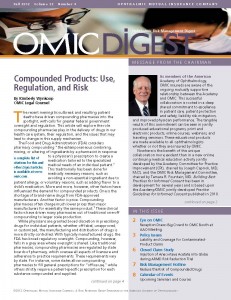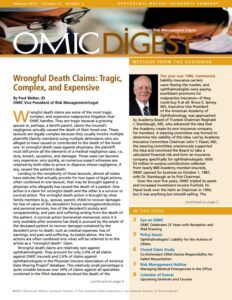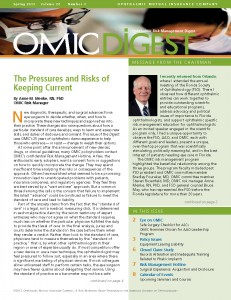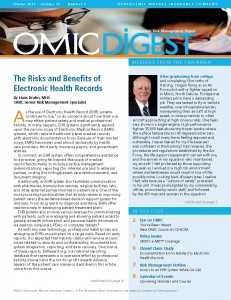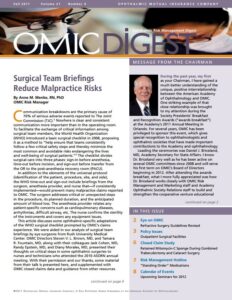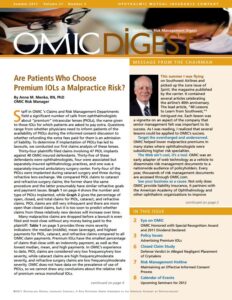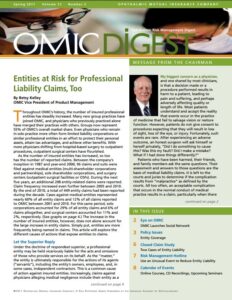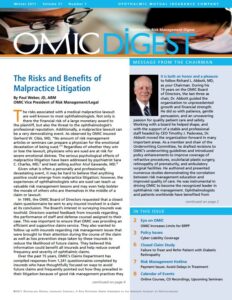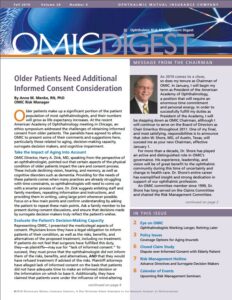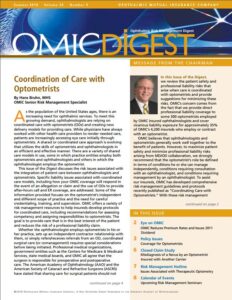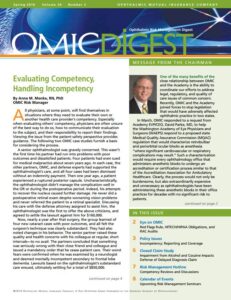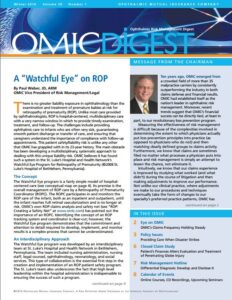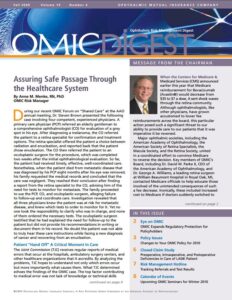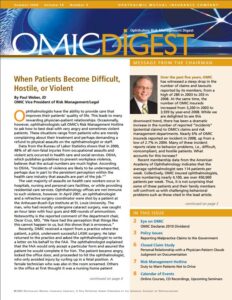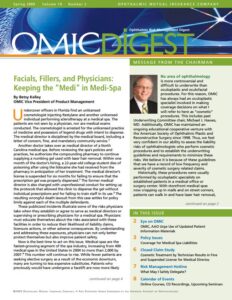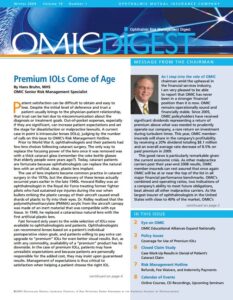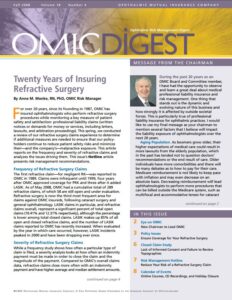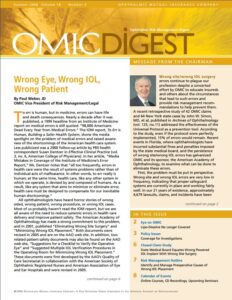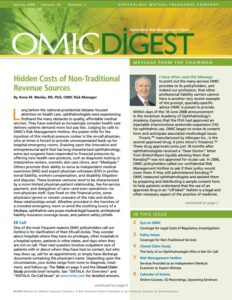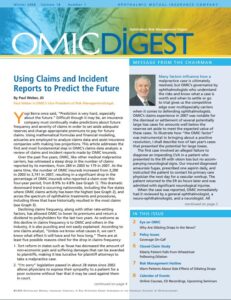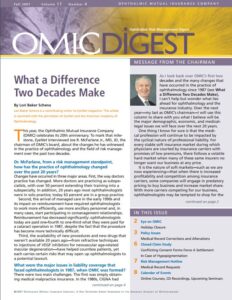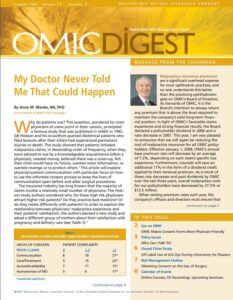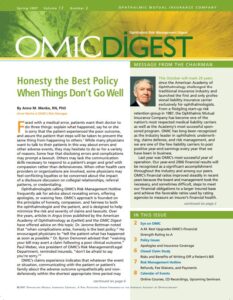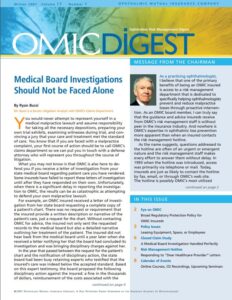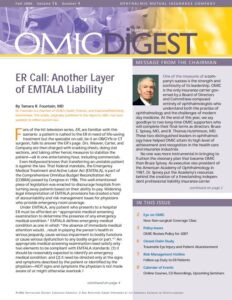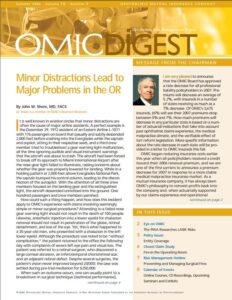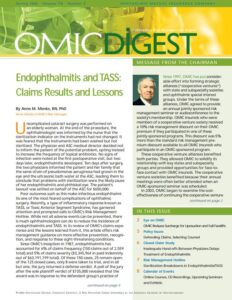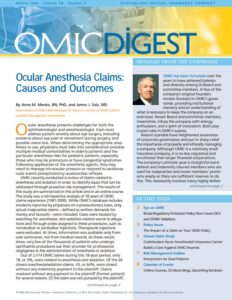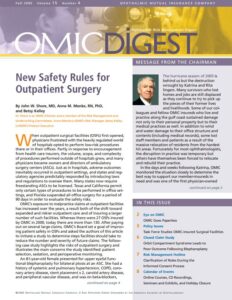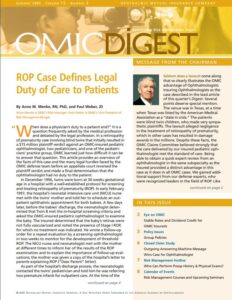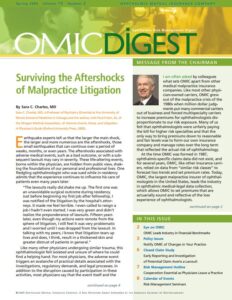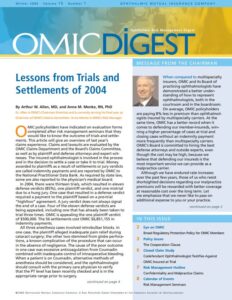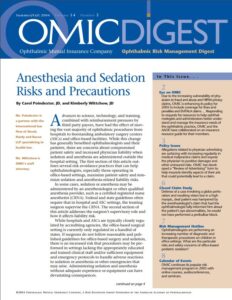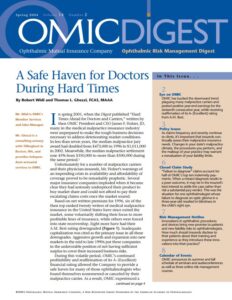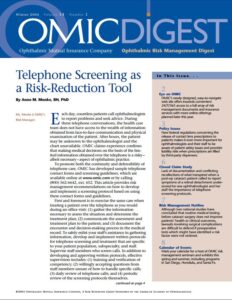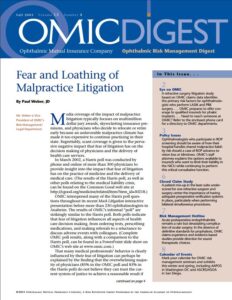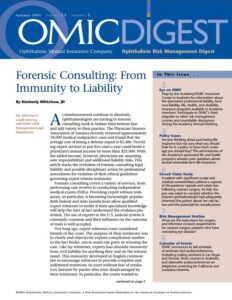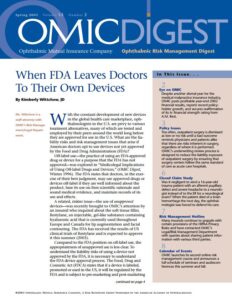Compounded Products: Use, Regulation, and Risk
Kimberly Wynkoop, OMIC Legal Counsel
Digest, Fall 2012
The recent meningitis outbreak and resulting patient deaths have driven compounding pharmacies into the spotlight, with calls for greater federal government oversight and regulation. This article will explore the role compounding pharmacies play in the delivery of drugs in our health care system, their regulation, and the issues that may lead to change in this supply mechanism.
The Food and Drug Administration (FDA) considers pharmacy compounding “the extemporaneous combining, mixing, or altering of ingredients by a pharmacist in response to a physician’s prescription to create a medication tailored to the specialized medical needs of an individual patient.”[1] This traditionally has been done for medically necessary reasons, such as avoiding a non-essential ingredient due to patient allergy, or voluntary reasons, such as adding flavor to a child’s medication. More and more, however, other factors have influenced the demand for compounded products. One is the shortage of brand-name drugs from FDA-approved manufacturers.[2] Another factor is price. Compounding pharmacies often charge much lower prices than major manufacturers for essentially the same product.[3] These clinical factors have driven many pharmacies out of traditional one-off compounding to larger scale production.
While physicians are granted broad discretion in prescribing drugs for individual patients, whether off-label, unapproved, or customized, the manufacturing and distribution of drugs is more strictly controlled. With typically manufactured drugs, the FDA has broad regulatory oversight. Compounding, however, falls in a grey area where oversight is shared. Like traditional pharmacies, compounding pharmacies are regulated by state boards of pharmacy, which oversee all aspects of licensure and adherence to practice requirements. These requirements vary by state. For instance, some states allow compounding pharmacies to fill general prescriptions for “office use,” while others strictly require a patient-specific prescription for each substance compounded and supplied.
The federal government’s authority over compounding pharmacies is more complicated. The FDA has the authority to inspect compounding pharmacies to ensure the drugs and active pharmaceutical ingredients they use are safe. But what about FDA control over the finished product? The Food, Drug, and Cosmetic Act (FDCA) establishes FDA jurisdiction over “new drugs.” The FDA’s position, with supporting judicial authority, is that compounded drugs fall under the new drug definition. As “new drugs,” the FDCA generally prohibits compounded drugs from being introduced into interstate commerce since they lack any FDA finding of safety and efficacy.[4] Despite the unapproved status of compounded drugs, the FDA has long recognized that traditional pharmacy compounding serves an important public health function and has not often enforced this prohibition.[5]
Compounded Trypan Blue and Avastin Contaminated
However, instances of compounded drugs endangering public health have given rise to concern within the FDA. One such instance occurred in 2005 at a Washington, DC, Veterans Administration hospital where bacteria-contaminated Trypan Blue Ophthalmic Solution, compounded for use in cataract surgery, blinded two patients and damaged vision in several others.[6] A more recent example: In the summer of 2011, at least a dozen patients in the Miami area contracted streptococcus endophthalmitis from tainted compounded Avastin.[7]
The FDA may not necessarily know about all instances of public harm since, unlike commercial drug manufacturers, pharmacies aren’t required to report adverse events associated with their products. The Limited FDA Survey of Compounded Drug Products, published in 2006, found quality problems in compounded drugs, including potency issues and contamination. The active pharmaceutical ingredients passed inspection, so the failures of the finished drug products were considered likely due to the compounding processes themselves. The FDA concluded that, given their widespread use and the potential for serious injury, the quality of compounded drugs constitutes an important public health concern.[8]
Adding to the complexity of federal regulation of compounding pharmacies, there are two different analyses for regulation depending on the applicable judicial circuit. In 1997, Congress passed the Food and Drug Administration Modernization Act (FDAMA), which added section 503A[9] to the FDCA exempting compounded drug products from the adulteration, misbranding, and new drug provisions of the FDCA as long as certain requirements were met.[10] In 2002, the US Supreme Court found that some of the requirements for the exemptions were unconstitutional.[11] The Fifth Circuit Court of Appeals thereafter ruled that this didn’t invalidate the rest of section 503A.[12] So in the Fifth Circuit (Texas, Louisiana, and Mississippi), the FDA applies the section 503A exemptions.
In the rest of the Unites States, the FDA maintains its original reach and does not apply section 503A. Instead, it follows the revised FDA compliance policy guide (CPG) on pharmacy compounding.[13] The CPG sets forth a non-exhaustive list of nine factors (many drawn from Section 503A) that the FDA considers in determining whether to take enforcement action against a pharmacy when the scope and nature of its activities raise the kind of concerns ordinarily associated with drug manufacturing. These factors include the compounding of drug products that (1) have been pulled from the market because they were found to be unsafe or ineffective; (2) are essentially copies of commercially available drug products; or (3) were compounded in advance of receiving prescriptions, except in very limited quantities relating to the amounts of drugs previously compounded based on valid prescriptions.
Through the CPG, the FDA assures compounding pharmacies that its main concern is those pharmacies that are effectively engaging in multi-patient “manufacturing” under the guise of compounding.[14] The FDA prioritizes enforcement actions related to compounded drugs using a risk-based approach, giving the highest enforcement priority to pharmacies that compound products that are causing harm or that amount to health fraud. However, the FDA has recently stated that this doesn’t mean that the FDA will take enforcement action only if the agency identifies a particular safety problem.[15] It may also take action when copies of FDA-approved drugs are being created in large volumes for no apparent medical need.
Brilliant Blue G Linked to 33 Endophthalmitis Cases
A look at the recent Brilliant Blue G recall provides insight into how the FDA is applying its enforcement discretion and the factors it is taking into consideration. In Los Angeles in March 2012, nine cases of fungal endophthalmitis were diagnosed in patients who had undergone vitrectomies with epiretinal membrane peeling using the Brilliant Blue-G (BBG) dye from Franck’s Compounding Lab (“Franck’s”) in Ocala, Florida. Local and state health departments, the Centers for Disease Control and Prevention (CDC), and the FDA collaborated in the investigation. It was expanded to include injectable drug products containing triamcinolone due to reports of eye infections in patients who received it during eye surgery. As of April 30, 2012, there were a total of 33 endophthalmitis cases in seven states. In May, the CDC advised health care providers to avoid use of any compounded products labeled as sterile from Franck’s during the ongoing investigation.
The FDA issued a warning letter to Franck’s on July 9, 2012, based on its March–May inspection of the lab.[16] The FDA identified various microorganisms in samples of the compounded BBG that matched the clinical isolates from patients who developed fungal endophthalmitis. Multiple bacterial and fungal species were found at Franck’s in several locations where sterile drugs were compounded and other unsanitary conditions were also identified. The FDA determined that Franck’s BBG injection drug product was adulterated under the FDCA due to the contaminants present. Further, this drug and all sterile drugs compounded by Franck’s were found to be adulterated in that they were prepared, packed, or held under unsanitary conditions. The FDA also concluded that the BBG products were misbranded because their labeling was false or misleading since the drugs were labeled incorrectly as being sterile. The FDA advised Franck’s that failure to promptly correct these deficiencies could result in legal action. In May, Franck’s stopped compounding sterile drugs.[17]
NECC’s Ophthalmic Drugs Also Under Scrutiny
Only four months later, a new illness outbreak based on compounded drugs quickly overshadowed the BBG debacle and precipitated intense scrutiny of the compounding industry. What began as a single reported case of meningitis September 21, 2012, in Tennessee, has burgeoned, according to the CDC’s November 19, 2012, report[18], to 490 cases of fungal disease, including 34 deaths spread across 19 state—all linked to contaminated epidural steroid injections compounded by the New England Compounding Center (NECC), Framingham, Massachusetts. The CDC traced the meningitis outbreak to three lots of the compounded steroids that were distributed to 75 medical facilities in 23 states, affecting as many as 14,000 patients.[19] On October 15, 2012, the FDA further advised health care providers to follow-up with patients who received any NECC injectable product after May 20, 2012, including injectable ophthalmic drugs and those used in conjunction with eye surgery.[20]
The recalls and investigation have been a coordinated effort between the NECC, FDA, CDC, and Massachusetts Department of Public Health (DPH) Board of Registration in Pharmacy, which has state regulatory authority over the NECC. At the request of the DPH, the NECC agreed to voluntarily surrender its license to operate during the investigation; it now has been permanently revoked. The DPH Board of Pharmacy report released October 23, 2012, identified serious deficiencies and significant violations of pharmacy law and regulations by the NECC.[21] Evidently, the NECC solicited bulk orders and distributed large quantities of product for general use rather than requiring a prescription for each individual patient as state law requires.[22] The NECC did not follow proper sterilization standards and shipped some orders of drugs before waiting for the final results of sterility testing. The Board found many unsanitary conditions at the NECC site as well.
The meningitis outbreak, following shortly on the heels of the BBG endophthalmitis cases, has prompted health officials and lawmakers to call for immediate changes in the oversight of compounding pharmacies arguing that, because no one entity has full responsibility for overseeing compounding pharmacies, they essentially slide through the cracks.[23] The Governor of Massachusetts has already declared that the state will begin making unannounced inspections of pharmacies that prepare injectable medications and require that they submit annual reports detailing what they produce, how much, and where it is distributed. As of November 19, 2012, fifteen states were implementing new, or increasing enforcement of existing, regulations on compounding pharmacies. These states require an individual patient prescription for every compounded medication order. This concerns the American Academy of Ophthalmology and American Society of Retina Specialists because it limits an ophthalmologist’s ability to purchase bulk quantities of commonly-used compounded ophthalmic drugs. These groups are working together to keep the focus of reform on improved patient safety (i.e., sterility issues), rather than distribution regulations that have the potential to limit drug availability.[24]
On the federal level, Congress is investigating the outbreaks and is considering legislative action to strengthen federal drug safety regulations. On November 1, 2012, the VALID Compounding Act was proposed to preserve state regulatory authority over traditional small compounding pharmacy activities, while ensuring that compounding pharmacies operating as drug manufacturers are regulated by the FDA.[25]
Lawsuits against the NECC and its executives have been filed in several states and patients have begun suing their providers as well. As we have seen in the cases of Trypan Blue, Avastin, BBG, and the NECC’s ophthalmic products, the drugs and devices that ophthalmologists obtain from compounding pharmacies are not without risk. Please see the Policy Issues article for a discussion of liability risks and policy coverage and the Hotline article for steps ophthalmologists can take to limit their liability and minimize the risks to the patients they treat when utilizing compounding pharmacies.
[1] US Department of Health & Human Services, US Food & Drug Administration, “2006 Limited FDA Survey of Compounded Drug Products,”n.d., http://www.fda.gov/Drugs/GuidanceComplianceRegulatoryInformation/PharmacyCompounding/ucm204237.htm (accessed April 5, 2012).
[2] Timothy W. Martin, Thomas M. Burton, and Jennifer Corbett Dooren, “Outbreak Spurs Calls for New Controls,” Wall Street Journal, Updated October 9, 2012, 2:41 pm ET, http://online.wsj.com/article/SB10000872396390443982904578044682649925200.html (accessed November 5, 2012).
[3] For example, compounding pharmacies provide a much cheaper version of the brand named drug Makena (used to reduce the risk of premature births). Once the drug got FDA approval, its manufacturer charged 100 times more than compounders. The FDA wanted to ban compounded versions on the grounds that Makena had met the FDA’s rigorous safety standards, but senior Obama officials concerned about price halted the ban. Denise Grady, Andrew Pollack, and Sabrina Tavernise, “Scant Oversight of Drug Maker in Fatal Meningitis Outbreak,” New York Times, October 6, 2012.
[4] US Department of Health & Human Services, US Food & Drug Administration, “Warning Letter to J&F International Inc.,” April 9, 2010, http://www.fda.gov/ICECI/EnforcementActions/WarningLetters/2010/ucm208772.htm (citations omitted).
[5] US Department of Health & Human Services, US Food & Drug Administration, “2006 Limited FDA Survey of Compounded Drug Products,” http://www.fda.gov/Drugs/GuidanceComplianceRegulatoryInformation/PharmacyCompounding/ucm204237.htm (accessed April 5, 2012).
[6] US Department of Health & Human Services, US Food & Drug Administration, “The Special Risk of Pharmacy Compounding,” May 31, 2007, http://www.fda.gov/ForConsumers/ConsumerUpdates/ucm107836.htm.
[7] US Department of Health & Human Services, US Food & Drug Administration, “FDA Alerts Health Care Professionals of Infection Risk from Repackaged Avastin Intravitreal Injections,” Updated August 30, 2011, http://www.fda.gov/Drugs/DrugSafety/ucm270296.htm.
[8] US Department of Health & Human Services, US Food & Drug Administration, “2006 Limited FDA Survey of Compounded Drug Products,” http://www.fda.gov/Drugs/GuidanceComplianceRegulatoryInformation/PharmacyCompounding/ucm204237.htm (accessed April 5, 2012).
[9] 21 U.S.C. 353a.
[10] Office of Regulatory Policy and Office of Compliance, Center for Drug Evaluation and Research, Food and Drug Administration, “Guidance for FDA Staff and Industry, Compliance Policy Guides Manual, Section 460.200, Pharmacy Compounding,” May 2002, http://www.fda.gov/ora/compliance_ref/cpg/cpgdrg/cpg460-200.html.
[11] Thompson v. Western States Med. Ctr., 535 U.S. 375 (2002).
[12] Medical Ctr. Pharmacy v. Mukasey, 536 F.3d 383 (5th Cir. 2008).
[13] The first CPG was issues March 16, 1992. This CPG remained in effect until 1997 when Congress enacted the FDAMA.
[14] “Compounding,” Wikipedia, http://en.wikipedia.org/wiki/Compounding (accessed April 4, 2012).
[15] US Department of Health & Human Services, US Food & Drug Administration, “Questions and Answers on Updated FDA Statement on Compounded Versions of hydroxyprogesterone caproate (the active ingredient in Makena),” Updated June 29, 2012, http://www.fda.gov/newsevents/newsroom/pressannouncements/ucm310215.htm.
[16] US Department of Health & Human Services, US Food & Drug Administration, “Warning Letter to Franck’s Lab Inc.,” July 9, 2012, http://www.fda.gov/ICECI/EnforcementActions/WarningLetters/2012/ucm312645.htm.
[17] Carlos E. Medina, “Franck’s Pharmacy closes its doors,” Ocala.com, July 31, 2012, http://www.ocala.com/article/20120731/ARTICLES/120739961?p=3&tc=pg.
[18] Center for Disease Control and Prevention, “Multistate Fungal Meningitis Outbreak – Current Case Count,” Updated November 19, 2012, http://www.cdc.gov/hai/outbreaks/meningitis-map.html.
[19] “New England Compounding Center meningitis outbreak,” Wikipedia, http://en.wikipedia.org/wiki/2012_US_meningitis_outbreak (accessed November 5, 2012).
[20] US Department of Health & Human Services, US Food & Drug Administration, “Update on fungal Meningitis,” http://www.fda.gov/Drugs/DrugSafety/FungalMeningitis/default.htm (accessed November 1, 2012).
[21] Abby Goodnough, “Sterility Found Lacking at Drug Site in Outbreak,” The New York Times, October 23, 2012, http://www.nytimes.com/2012/10/24/health/sterility-found-lacking-at-drug-site-in-meningitis-outbreak.html?pagewanted=all.
[22] Toni Clarke and Aaron Pressman, “Meningitis-linked firm sold drugs without requiring prescriptions-emails,” Reuters, October 13, 2012, http://www.reuters.com/assets/print?aid=USL5E8LD0CQ20121013.
[23] Timothy W. Martin, Thomas M. Burton, and Jennifer Corbett Dooren, “Outbreak Spurs Calls for New Controls,” Wall Street Journal, Updated October 9, 2012, 2:41 pm ET, http://online.wsj.com/article/SB10000872396390443982904578044682649925200.html (accessed November 5, 2012).
[24] American Academy of Ophthalmology, “Deadly Meningitis Outbreak Prompts Lawmakers to Consider Tighter Regulations on Compounding Pharmacies,” Member Alert, November 19, 2012.
[25] “Markey Announces Legislation to Strengthen Compounding Pharmacy Regulations,” Congressman Edward J. Markey’s Website, November 1, 2012.
Coverage On-Call
Taking call or arranging for call in your absence is an important part of most physicians’ practice. However, this situation gives rise to the following questions: (a) When does my medical malpractice liability insurance cover me for taking call and (b) When is it appropriate for me to take call under these circumstances?
Limited Scope Ophthalmologists
On-Call
One question that arises is whether an ophthalmologist in a limited coverage class [i.e., Ophthalmology Surgery Class 1 (very limited surgery), Class 2 (limited surgery), or No Surgery] is covered by OMIC for taking call for colleagues who provide a full scope of ophthalmic services, or for a hospital emergency room. Under OMIC’s policy, the ophthalmologist is covered for taking such call as long as she only provides those services permitted under her coverage class when she advises and treats patients. If she cannot feasibly and promptly obtain the services of another ophthalmologist to provide care that is outside her scope of coverage, she should consider discussing with an OMIC risk management specialist whether to continue the on-call activity.
OMIC’s Risk Management Department provides advice on when to take call in order to help our insureds reduce their liability risk and support overall quality of care. Paul Weber, OMIC Vice President of Legal/Risk Management, notes in “Who’s On Call?” (available at www.omic.com) that being “on call” by definition means that a physician is ready and legally able to render medical or surgical care to patients on an urgent or emergent basis. This includes being able to see and treat patients in the office or emergency room and admitting them to a hospital if necessary. Ideally, ophthalmologists who take call for their colleagues or private practice should have a coverage classification sufficient to diagnose and treat patients themselves. By having the full coverage classification of Surgery Class 3 when taking call, an ophthalmologist generally has the ability to not only diagnose the condition but treat it as well, thereby avoiding delays in care. This is especially true when taking ER call, where patients are more likely to present with truly emergent conditions.
The difference between OMIC’s policy coverage and risk management recommendations is that the terms and conditions of the policy are binding upon the insured in order for insurance to cover a claim. Risk management recommendations provide useful tools in managing the risks of medical practice and reinforcing the standard of care for our insureds’ patients. However, it is not mandatory to implement this risk management advice.
Insureds need to decide for themselves whether they will continue to take call when they are in a limited coverage class. They should do so with the understanding that anything that exceeds the limits of their coverage class must be promptly referred to another physician. Only the insured can decide whether such referral can take place in a timely manner, whereby the patient does not suffer a delay that would contribute to a worsening of the injury or medical condition.
Optometrists On-Call
OMIC offers professional liability insurance to optometrists employed by our ophthalmologist and entity insureds. We have had queries about whether employed optometrists are covered by OMIC’s policy for taking call on behalf of their employers or other ophthalmologists. Under the policy, the optometrist is covered for taking call as long as he is acting within the scope of his training, licensure, and employment by the ophthalmologist/entity when he advises and treats patients.
However, in order for the optometrist to be added to an OMIC policy as an insured, his call services must first be analyzed and approved by OMIC’s Underwriting Department during the application process. A detailed explanation of the nature and volume of the calls and scope of responsibilities when on call must be provided. An underwriter will assess the liability risk of the optometrist’s call. There is a lower risk of liability when an optometrist is screening calls and making referrals only, versus the higher risk of personally examining patients and making independent treatment decisions for an ophthalmologist’s patients. The underwriter reviews the protocols in place for handling trauma, surgical complications, emergency call requiring the patient to be seen, and referring or transferring care to a backup ophthalmologist. In order for coverage to be approved, an ophthalmologist must always be available to promptly take patient referrals.
In “Who’s On Call?,” Paul Weber points out that optometrists’ call coverage is more limited than that which can be provided by an ophthalmologist.
Due to state laws limiting the optometric scope of practice, as well as differences in training between optometrists and ophthalmologists, optometrists generally should not take call on behalf of ophthalmologists.
However, their special training and skill does allow them to handle a number of questions or situations that might arise, so limited call with backup resources and referral/transfer protocols in place may be appropriate.
OMIC Can Help
If you are an optometrist covered by OMIC and your call services have changed since you fi rst applied for coverage, you must notify OMIC’s Underwriting Department at (800) 562-6642, ext. 639, so we can assess your liability risk and continue to approve coverage of your practice.
Ophthalmologists should contact their underwriter if they have questions about call coverage. For assistance with decision making about when and how to take or assign call, contact OMIC’s Risk Management Hotline at ext. 641.
Office-Based Surgery for Adults
Some ophthalmic surgical procedures can be safely performed in an office surgical suite. Others with higher risk profiles raise a number of concerns. If a patient experiences a serious complication or poor outcome and decides to sue the ophthalmologist, all aspects of the care will be questioned, including the decision to perform the procedure in the office. Office Based Surgery for Adults provides an overview of the issues associated with office based surgery for adults.
Click on “recommendations” in the toolbar above to download the analysis.
Denise Chamblee, MD selected for the Academy’s Leadership Development Program (LDP) XV
 OMIC Board Member Denise Chamblee, MD was recognized at the American Academy of Ophthalmology’s Joint Meeting with the Asia Pacific Academy of Ophthalmology in Chicago for her selection to the Academy’s Leadership Development Program XV, Class of 2013. Dr. Chamblee was nominated by OMIC to join a select group of twenty participants chosen from among a large group nominated by state, subspecialty and specialized interest societies. The class also includes one international from Vietnam who is jointly representing the Asia Pacific Academy of Ophthalmology and the Vietnam Ophthalmology Society. The incoming LDP class had an Orientation Session in Orlando where they were introduced to their classmates as well as heard project presentations from the graduating LDP XIV, class of 2012.
OMIC Board Member Denise Chamblee, MD was recognized at the American Academy of Ophthalmology’s Joint Meeting with the Asia Pacific Academy of Ophthalmology in Chicago for her selection to the Academy’s Leadership Development Program XV, Class of 2013. Dr. Chamblee was nominated by OMIC to join a select group of twenty participants chosen from among a large group nominated by state, subspecialty and specialized interest societies. The class also includes one international from Vietnam who is jointly representing the Asia Pacific Academy of Ophthalmology and the Vietnam Ophthalmology Society. The incoming LDP class had an Orientation Session in Orlando where they were introduced to their classmates as well as heard project presentations from the graduating LDP XIV, class of 2012.
In January 2013, Dr. Chamblee will take part in a 2 ½ day interactive session in San Francisco with a visit to AAO headquarters to hear from AAO physician leadership on a wide variety of leadership topics. Next will be a trip in April 2013 to attend the AAO’s Mid-Year Forum in Washington D.C. where she will have scheduled visits with Senators and Representatives to discuss issues important to the medical profession. During an advocacy session dedicated to LDP XV participants , Dr. Chamblee will also hear from a member of the US Congress and key health staff about building effective relationships with legislators and how best to advocate on behalf of patients. The final LDP session for the class of 2013 will take place in conjunction with the Academy’s Annual Meeting in New Orleans.
OMIC Digest Archives 2012-2003

